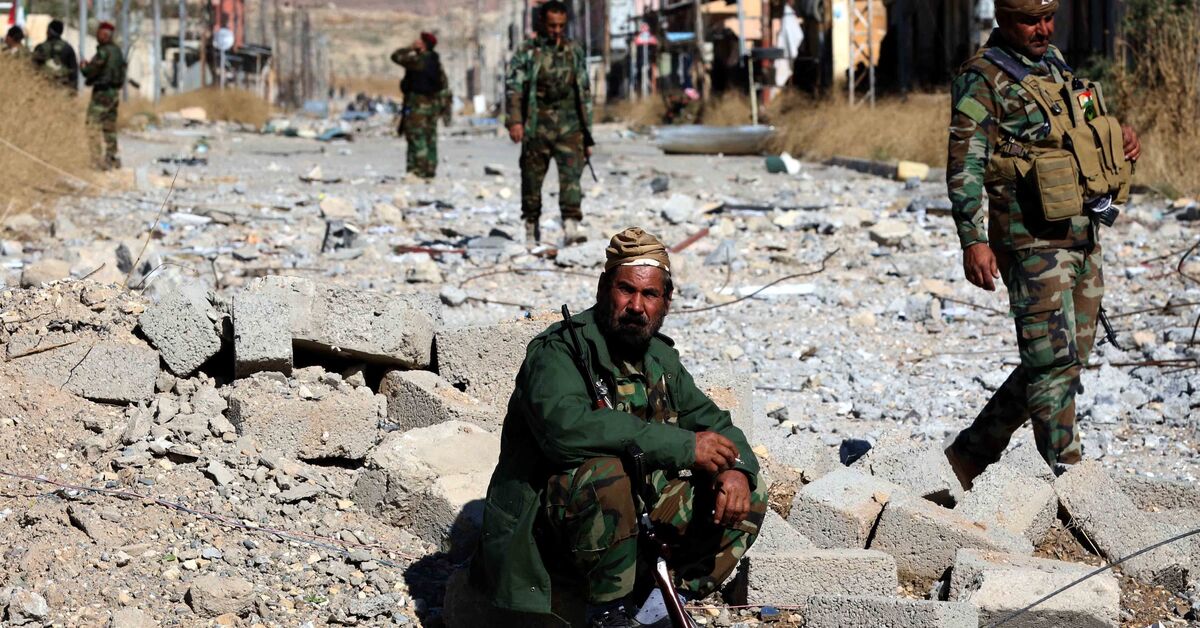PKK’s new-tech missiles fuel Turkey’s suspicion of Iranian role
The Kurdistan Workers’ Party (PKK) may have used Iranian-made loitering munition to shoot down Turkish armed drones, regional sources said, suggesting strengthening ties between Tehran and the group outlawed by Turkey.
On 27 May, the PKK, which has been fighting the Turkish state since 1984 in pursuit of greater Kurdish rights, released footage purportedly showing the downing of a Turkish armed drone, identified as an Aksungur.
This claim follows a similar allegation made in March, when the PKK suggested it had acquired technology capable of targeting Turkish unmanned aircraft.
Three independent defence experts who analysed the PKK’s latest video, who spoke to Middle East Eye on condition of anonymity due to the sensitivity of the subject, said it is highly likely the Turkish drone was downed by the Iranian 358 loitering surface-to-air missile, also known as a “kamikaze” drone.
Two experts noted that the 358 is a relatively slow munition, which is why it might not be visible in the footage due to its lack of a rocket engine.
Stay informed with MEE’s newsletters
Sign up to get the latest alerts, insights and analysis,
starting with Turkey Unpacked
“This is a jet-propelled missile. It flies very slowly and, because it’s not rocket-propelled, if it misses, it tries to turn around and hit the target again,” one expert told MEE.
Supplied by Iran, assembled in Iraq
An Iraqi source close to the PKK, contacted by MEE, claimed that Iran had supplied the 358 system in parts, which the PKK then assembled. This process, according to the source, has been going on for about two years, with some assembly occurring south of Sulaymaniyah.

Has the PKK acquired kamikaze drones to hit Turkish aircraft?
Read More »
When approached by MEE, Turkish defence ministry sources declined to comment on the matter.
Two experts highlighted that the PKK would need a radar system or similar technology to operate the loitering missile, given that Turkish drones often fly at high altitudes. They suggested that, besides Iran, the only other entity capable of providing such location information about Turkish drones in Iraq is the United States.
“The technology must be transferred from Iran. The PKK may have set up a technical team to use this technology,” a third expert said.
Last month, Turkey’s defence minister, Yasar Guler, told a Turkish newspaper that Iran had not been cooperative with Ankara in its fight against the PKK, despite Turkey’s efforts to monitor the group’s movements and inform Tehran.
“Unfortunately, our Iranian friends do not regard PKK terrorists in the same way as we do,” Guler said.
“We say, ‘Look, brother, the PKK is here, in that house, this is the address where they are staying,’ and after a short while, the answer comes, ‘Sir, we researched that address, there is no such person.’ Of course, this is not acceptable.”
‘The technology must be transferred from Iran. The PKK may have set up a technical team to use this technology’
– Defence expert
Iran denies turning a blind eye to the PKK’s movements and activities. The Qandil Mountains, part of which lies inside Iran, serve as the PKK’s main stronghold in northern Iraq. According to Turkish officials, PKK senior cadres have survived Turkish air strikes by taking refuge on the Iranian side.
Turkish security sources, speaking anonymously to MEE, claimed that Iran is increasingly strengthening its ties with the PKK against both Turkey and the Kurdistan Regional Government (KRG) in Iraq.
“The growing ties between Iraq’s Patriotic Union of Kurdistan and the PKK, along with Iran-backed Iraqi groups, are beyond regular engagements,” one security source said, referring to one of the main political blocs in the KRG.
Another Turkish source, familiar with the issue, said Ankara is closely monitoring Iran and its proxies’ recent moves in Iraq, suspecting them of trying to destabilise the region in response to Turkey’s rapprochement and cooperation efforts with Iraq.
Munition used by regional allies
The 358 missile is a favoured munition among Iran’s proxies and allies throughout the Middle East. In late 2019, 358s were found in an Iranian shipment seized by the United States en route to Yemen. A second shipment was intercepted in February 2020.
Iran, which has conducted prolonged attrition attacks against the United States in Iraq, has also sent 358 missiles to its proxies in the country. Iraqi militias displayed this ammunition in 2021.
Since the 7 October start of the war between Israel and Hamas in Gaza, at least four US MQ-9 Reaper drones operating in the region to prevent attacks by Houthis in Yemen on Israel and targets in the Red Sea were shot down with Iranian-made surface-to-air missiles by the Houthis.
The 358 missile is also in the arsenal of Hezbollah in Lebanon and has been used against Israel in cross-border hostilities since the start of the war on Gaza. Israeli and Hezbollah media reported that various Israeli unmanned aerial vehicles had been targeted with the 358 missile.
The third defence expert warned that the proliferation of advanced systems like the 358 missile could soon threaten air traffic, including helicopters and emergency evacuation operations, across all states in the region.




